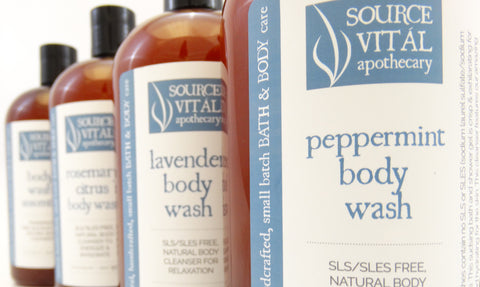The 5 Reasons We Never Use SLS/SLES

Just like with the food that we eat, more and more people are concerned about what’s in the products they use on their skin every day.
Sodium Lauryl Sulfate (SLS) and Sodium Laureth Sulfate are two additives that have emerged as ingredients to avoid.
We will save you the complicated Chemistry, so let’s just say according to the information available, SLS/SLES fails to meet our standards of skin and body care products that work with the skin and not against it.
Here are the top 5 reasons you won’t find SLS/SLES and associated chemicals in any Source Vitál products.
1. Cheap Additives
Sodium lauryl sulfate (SLS) and Sodium laureth sulfate (SLES) are inexpensive surfactants found in soaps, toothpaste, detergents, bubble baths, shampoos and many other personal care and cosmetic products. Esters of sulphuric acid, SLS and SLES are essentially cheap additives used for their cleansing and emulsifying capabilities and ability to foam.
Instead of filling our products with these inexpensive additives we have worked to source alternatives that are made from natural, green, sustainable sources. Our new line of SLS/SLES free Body Washes effectively, yet gently cleanse the skin without the potentially harmful and cheap additives that are found in so many bath products.
2. Not needed
We are conditioned to believe that clean equals a good foamy lather. This isn’t the case. Yes, there is something satisfying to working up our shampoo or body washes into a delicious looking frothy masterpiece, but too often those bubbles can strip the skin of vital moisture, damaging the protective barrier that keeps our skin safe from irritations.
3. Irritating to Skin & Eyes
According to the Cosmetic Ingredient Review (CIR), the use of products containing SLS and SLES are irritating to the skin and eyes. Some instances claim that these ingredients may cause permanent eye damage. Pretty scary, huh?
Fortunately, the CIR concludes that while SLS/SLES can cause irritations, they are considered safe for general use or when a product with SLS/SLES is removed quickly from the skin. However, as mentioned above, there are better, safer alternatives without the risk of these side effects.
4. Allows chemicals to soak into the skin (Penetration Enhancers)
SLS/SLES are known penetration enhancers. This means they alter the epidermal (skin) structure and allow other chemicals to more easily sink into skin. This isn’t necessarily a bad thing, especially if the chemicals that are going deeper into the skin are pure and natural, but at the same time they are making way for potentially harmful substances as well.
5. Potential for Contamination
The process of manufacturing SLS and SLES may allow for the presence of chemical carcinogens such as nitrates.
Additionally, while SLS/SLES are very similar chemicals they are in fact different. SLES is a milder version that is produced by modifying SLS with ethylene oxide. This ethoxylation process has become a concern as it has been found to produce 1,4-Dioxane, a known carcinogen. SLES contains trace amounts of 1.4-Dioxane but no studies have been able to prove that either SLS or SLES cause cancer or disrupt the development of DNA.
As you can see there are a lot of yucky associations with SLS/SLES. We could rely on the CIR conclusions that it is generally safe but, really we can’t get over the potential for skin irritations and the fact that there are more natural options that are just better for the skin.
Our mission is to formulate high quality skin and body care that works with the skin and not against it. That’s our guarantee on every product we make and why you will never find these additives in any of our products for skin, body and spirit.
If you would like to read more about SLS/SLES click here, visit the Cosmetic Ingredient Review www.cir-safety.org, or check out Truth In Aging at www.truthinaging.com.


Leave a comment